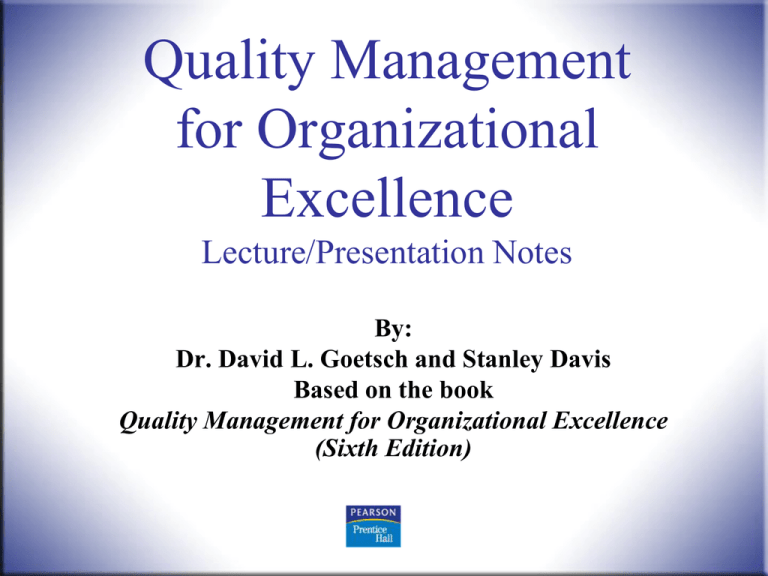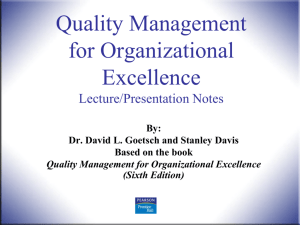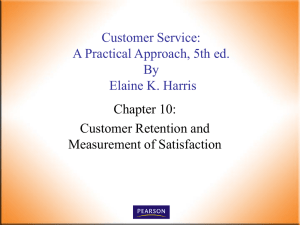
Quality Management
for Organizational
Excellence
Lecture/Presentation Notes
By:
Dr. David L. Goetsch and Stanley Davis
Based on the book
Quality Management for Organizational Excellence
(Sixth Edition)
Quality Management, 6th ed.
Goetsch and Davis
1
© 2010 Pearson Higher Education,
Upper Saddle River, NJ 07458. • All Rights Reserved.
Nineteen:
Continual Improvement Methods with Six
Sigma, Lean, and Lean Six Sigma
MAJOR TOPICS
Rationale for Continual Improvement
Management’s Role in Continual
Improvement
Essential Improvement Activities
Structure for Quality Improvement
The Scientific Approach
Identification of Improvement Needs
Quality Management, 6th ed.
Goetsch and Davis
2
© 2010 Pearson Higher Education,
Upper Saddle River, NJ 07458. • All Rights Reserved.
Nineteen:
Continual Improvement
(Continued)
Major Topics Continued
Development of Improvement Plans
Common Improvement Strategies
Additional Improvement Strategies
The Kaizen Approach
Goldratt’s Theory of Constraints
The CEDAC Approach
Six Sigma Concept
Lean Operations
Lean Six Sigma
Quality Management, 6th ed.
Goetsch and Davis
3
© 2010 Pearson Higher Education,
Upper Saddle River, NJ 07458. • All Rights Reserved.
Nineteen:
Continual Improvement
(Continued)
The rationale for continual improvement is that it is
necessary in order to compete in the global
marketplace. Just maintaining the status quo, even
if the status quo is high quality, is like standing still
in a race.
Management’s role in continual improvement is
leadership. Executive-level managers must be
involved personally and extensively. The
responsibility for continual improvement cannot be
delegated.
Quality Management, 6th ed.
Goetsch and Davis
4
© 2010 Pearson Higher Education,
Upper Saddle River, NJ 07458. • All Rights Reserved.
Nineteen:
Continual Improvement
(Continued)
Essential improvement activities include the
following:
Maintaining communication
Correcting obvious problems
Looking upstream
Documenting problems and progress
Monitoring change
Quality Management, 6th ed.
Goetsch and Davis
5
© 2010 Pearson Higher Education,
Upper Saddle River, NJ 07458. • All Rights Reserved.
Nineteen:
Continual Improvement
(Continued)
● Structuring for quality improvement involves the
following:
Establishing a quality council
Developing a statement of responsibilities
Establishing the necessary infrastructure
Quality Management, 6th ed.
Goetsch and Davis
6
© 2010 Pearson Higher Education,
Upper Saddle River, NJ 07458. • All Rights Reserved.
Nineteen:
Continual Improvement
(Continued)
● Using the scientific approach means:
Collecting meaningful data
Identifying root causes of problems
Developing appropriate solutions
Planning and making changes.
● Ways of identifying improvement needs include
the following:
Multivoting
Seeing customer input
Studying the use of time
Localizing problems.
Quality Management, 6th ed.
Goetsch and Davis
7
© 2010 Pearson Higher Education,
Upper Saddle River, NJ 07458. • All Rights Reserved.
Nineteen:
Continual Improvement
(Continued)
Developing improvement plans involves the
following steps:
Understanding the process
Eliminating obvious errors
Removing slack from processes
Reducing variation in processes
Planning for continual improvement.
Quality Management, 6th ed.
Goetsch and Davis
8
© 2010 Pearson Higher Education,
Upper Saddle River, NJ 07458. • All Rights Reserved.
Nineteen:
Continual Improvement
(Continued)
Commonly used improvement strategies include
the following:
Describing the process
Standardizing the process
Eliminating errors in the process
Streamlining the process
Reducing sources of variation
Bringing the process under statistical control
Improving the design of the process.
Quality Management, 6th ed.
Goetsch and Davis
9
© 2010 Pearson Higher Education,
Upper Saddle River, NJ 07458. • All Rights Reserved.
Nineteen:
Continual Improvement
(Continued)
Additional improvement strategies include
the following:
Reducing leadtime
Flowing production
Using group technology
Leveling production
Synchronizing production
Overlapping production
Using flexible scheduling
Using pull control
Using visual control
Using stockless production
Quality Management, 6th ed.
Goetsch and Davis
10
© 2010 Pearson Higher Education,
Upper Saddle River, NJ 07458. • All Rights Reserved.
Nineteen:
Continual Improvement
(Continued)
● Additional improvement strategies include
the following:
Using jidoka
Reducing setup time
Applying in-process control
Improving quality
Applying total cost cycles
Using cost curves
Using the mushroom concept
Making suppliers comakers
Applying total industrial engineering
Applying total productive maintenance
Quality Management, 6th ed.
Goetsch and Davis
11
© 2010 Pearson Higher Education,
Upper Saddle River, NJ 07458. • All Rights Reserved.
Nineteen:
Continual Improvement
(Continued)
Kaizen is the name given by the Japanese to
the concept of continual incremental
improvement. It is a broad concept that
encompasses all of the many strategies for
achieving continual improvement and entails
the following five elements:
Straighten up
Put things in order
Clean up
Personal cleanliness
Discipline
Quality Management, 6th ed.
Goetsch and Davis
12
© 2010 Pearson Higher Education,
Upper Saddle River, NJ 07458. • All Rights Reserved.
Nineteen:
Continual Improvement
(Continued)
Goldratt’s theory of Constraints is another
approach used to achieve continual improvement
in the workplace. It involves the following steps:
Identify
Exploit
Subordinate
Eliminate restraints
Overcome inertia
Quality Management, 6th ed.
Goetsch and Davis
13
© 2010 Pearson Higher Education,
Upper Saddle River, NJ 07458. • All Rights Reserved.
Nineteen:
Continual Improvement
(Continued)
The following tools are used in applying
Goldratt’s Theory of Constraints:
Effect-cause-effect
Evaporating clouds
Prerequisite trees
The Socratic Method
Quality Management, 6th ed.
Goetsch and Davis
14
© 2010 Pearson Higher Education,
Upper Saddle River, NJ 07458. • All Rights Reserved.
Nineteen:
Continual Improvement
(Continued)
● CEDAC is an acronym for Cause-and-Effect Diagram with the Addition
of Cards. (This acronym is a registered trademark of Productivity,
Inc.) With CEDAC, a cause-and-effect diagram is developed, but fact
cards about problems and improvement cards containing ideas for
solving the problems are used.
● Six Sigma is a concept that attempts to reduce the defect rate to 3.4
per million or less. Lean is a concept that is used to eliminate waste
and improve process flow. Lean Six Sigma links the two concepts in
ways that combine the benefits of both. Key concepts in Lean Six
Sigma are the DMAIC Roadmap, Green Belts, Black Belts, Masters
Black Belts, and Champions.
Quality Management, 6th ed.
Goetsch and Davis
15
© 2010 Pearson Higher Education,
Upper Saddle River, NJ 07458. • All Rights Reserved.







